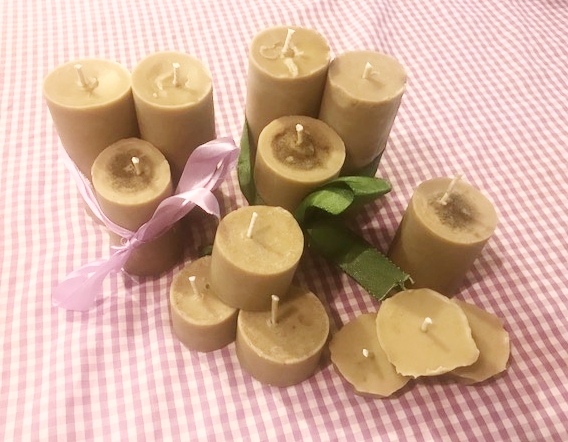During my year of buying, using, and wasting less, I focused on reducing my plastic use. I got rid of one-use items and found other methods of storing things, rather than relying on plastics. It wasn’t as hard as I had thought, mostly because I’d stopped using things like plastic wrap several years prior and already reused things like yogurt cartons and other plastic containers (hey, use what you’ve got—it’s better than throwing it out!).
I’d even invested in a few beeswraps over the years, too, although they were pretty expensive to invest in—typically around $20 for three or so beeswax-sealed cloths. So what’s a bruja to do when she’s wanting to find eco-friendly wrappers but not spend a small fortune? You guessed it: Make her own. I went down a Pinterest rabbit hole and found so many easy-to-follow recipes and discovered that not only is making your own beeswrap super easy, it is very affordable. I still have plenty of the ingredients and cotton fabric for when I want to make more—and that ways after making the green living equivalent of a deluxe Tupperware set for two families!
I spent the most money on fancy fabric because I couldn’t help myself! Who can resist avocado or cherry print cotton when you know you’re turning them into useful—and cute—kitchen tools? Plus, I’m a sucker for bright colorful prints in general, from dress patterns to beeswrap, it would seem. Still, you wouldn’t have to do the same. Any old cotton fabric will do as long as it is washed and ironed before you begin their beeswrapping transformation. That’s where the fun begins.
I can’t tell you how much fun I hade making these things. Part of the joy of sustainability is sharing with your family. Last holiday season, I made my family members large sets of beeswrap since I know they, too, are working on better green living practices, but don’t necessarily have the time to whip up a batch of homemade beeswrap. They're better for the environment—and the pocketbook, when making them yourself—and they become a gift that is truly a labor of love.
I have many a fond memory of wintery afternoons spend preparing these reusable wraps by twinkle lights and festive holiday decorations. My home was redolent with the smell of honey and pine for days after. I poured all the softness of honeyed thoughts in the making of them, along with the resiliency of pine resin, both things everyone needs for a new year. I sealed them with my love and the soft healing nourishment of time spent in the kitchen. If that doesn’t welcome in the holiday spirit, I don’t know what does!
Rather than walk you through each and every step I did to make these, I’m leaving you in the good hands of Mommypotomous. I used this recipe because I preferred how she sprinkled the ingredients directly on the cotton, which to me felt easier than melting them separately and painting them on, as Attainable Sustainable did. I also read about the pros and cons of using different ingredients, including vegan options, from Rose Mountain Herbs. They offer quite a few pro tips, too, for getting the exact kind of wrap you want.
My supplies: cotton fabric in fun colors, beeswax pastilles (they are easier to use here, providing even coverage), pine resin for stickiness, and jojoba oil to combine the ingredients and serve as an anti-bacterial agent.
Washed and ironed cotton cut to size on baking sheets lined with parchment paper. These cotton pieces, with beeswax, pine resin, and jojoba oil, are ready for the oven.
These cotton squares are fresh out of the oven and have been brushed to even out the melted ingredients over their surface. Be warned: once they go in the oven, they melt fast and, when you take them out, they harden quickly, so you have to act fast. But don’t worry, you can always pop them back in the oven if you need to reheat them to spread the beeswax mixture around more.
One other little tip: remove the cloth from the baking sheets while they are still warm. If you let them cool on the baking sheets, the excess beeswax mixture will stick to the back of the fabric.
The final product! These are great for storing dried goods like doggie treats or snacks on the go, to larger items. The great thing about making your own beeswax wrappers is that you get to choose the size and quantity. I made a variety for me and mine, from small ones, pictured above, to larger ones to wrap up leftovers to everything in between, pictured below. Plus, over time, when your beeswax coat beings to wear off, you simply pop them back in the oven with a little extra beeswax, resin, and oil and let it reseal itself.
In the end, me and mine have a gorgeous collection of reusable wraps. Every time I use them, I think of those cozy festive afternoons and warming smell of pine and honey.
Enchantment Learning & Living is an inspirational blog celebrating life’s simple pleasures, everyday mysticism, and delectable recipes that are guaranteed to stir the kitchen witch in you. If you enjoyed what you just read and believe that true magic is in the everyday, subscribe to my newsletter below for regular doses of enchantment. Want even more inspiration? Follow me on Instagram, Facebook, Pinterest, and Twitter. Here’s to a magical life!


























